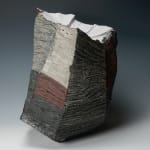Hiruma Kazuyo 昼馬和代 Japanese, b. 1947
H36.5 × W46.0 × D44.0 cm
Grand prize, Nikkokai exhibition
Further images
-
(View a larger image of thumbnail 1
)

-
(View a larger image of thumbnail 2
)

-
(View a larger image of thumbnail 3
)

-
(View a larger image of thumbnail 4
)

-
(View a larger image of thumbnail 5
)

-
(View a larger image of thumbnail 6
)

-
(View a larger image of thumbnail 7
)

-
(View a larger image of thumbnail 8
)

-
(View a larger image of thumbnail 9
)

-
(View a larger image of thumbnail 10
)

-
(View a larger image of thumbnail 11
)

-
(View a larger image of thumbnail 12
)

Hiruma lays thin sheets of clay horizontally or vertically to form each work followed by multiple glazes, Hiruma’s ceramic sculptures take us to vast natural scenery. She stretches the clay, beats the clay sheets, covers them with fabrics in order to impress them with the pattern of the weave, the final results give impressive impressions of erosion, rivers, waters and glaciers. Her labor-intensive process is rooted in, but not bound by, tradition. Hiruma’s artistic practice manifests space and movement through scale and weight. Powerful in size, these sculptures present us with a panoramic evocation of nature’s majesty and its sublime beauty.
"Dark brown earth, dry sand and wind on my cheeks, row upon row of surf-like forms that seemed to have been pulled from Earth’s core, concealing the processes by which living creatures had come down to the present..."
Here, Hiruma recalls a life-changing, quasi-mystical experience during a two-week visit to Arizona in the late 1980s, a place she had previously seen only in photographs. This revelatory encounter profoundly influenced her ceramic practice. Following this experience, she began working on "Kioku suru Daichi" (The Earth Remembers), "Suibun ni Kansuru Kioku" (Memories of Moisture), and other series that have since defined her career.











